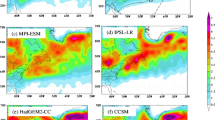Abstract
The speeds of historical cool-season extratropical cyclones along the U.S. east coast, hereafter East Coast Winter Storms (ECWS), occurring during the period from 1951 to 2006 were computed. Average storm speed was 13.8 ms−1 with stronger storms generally moving faster than weaker storms and faster storms forming during the midwinter months (December–March). There was no clear trend in ECWS speed during the time period, although considerable season-to-season variability was present. The monthly and seasonal variations in storm speed could not be attributed to the El Niño-Southern Oscillation or North Atlantic Oscillation (NAO) alone. However, the speed of ECWS was considerably slower when both El Niño and the negative phase of NAO occurred simultaneously. Characteristic patterns in the upper levels of the atmosphere, specifically 300 hPa zonal winds and 500 hPa geopotential heights, were present during periods when ECWS speeds were among the slowest (and separately fastest). For slow storm speed, these patterns also prevailed during months in which El Niño and negative NAO phase occurred. These patterns were also present during months with extended runs of high oceanic storm surge. This provides a qualitative link between the atmospheric conditions associated with slow storms and potentially high coastal storm surge impacts. Among the prime consequences of ECWS speed are extended periods of high storm surge, mainly due to slow-moving storms. The sustained high tidal levels often lead to substantial damage caused by coastal flooding, overwash, and beach erosion.







Similar content being viewed by others
References
Colle BA, Rojowsky K, Buonaito F (2010) New York City storm surges: climatology and an analysis of the wind and cyclone evolution. J Appl Meteorol Clim 49:85–99
Davis R, Dolan R, Demme G (1993) Synoptic climatology of Atlantic coast northeasters. Int J Climatol 13:171–189
Dolan R, Davis R (1992) An intensity scale for Atlantic Coast Northeast Storms. J Coast Res 8:840–853
Dolan R, Davis R (1993) Nor’easters. Am Sci 81:428–440
Eichler T, Higgins W (2006) Climatology and ENSO-related variability of North American extratropical cyclone activity. J Clim 19:2076–2093
Frankoski N, DeGaetano A (2011) An East Coast winter storm precipitation climatology. Int J Climatol 31:802–814
Gergis J, Braganza K, Fowler A, Mooney S, Risbey J (2006) Reconstructing El Niño Southern Oscillation (ENSO) from high-resolution palaeoarchives. J. Quart Sci 21(7):707–722
Halverson J, Radenhorst T (2010) Mega-snow in the megalopolis: the Mid-Atlantic’s Blockbuster winter of 2009–2010. Weatherwise 63:16–23
Hameed S, Shi W, Boyle J, Santer B (1995) Investigation of the centers of action in the Northern Atlantic and North Pacific in the ECHAM AMIP simulation. In: Proceedings of the 1st international AMIP science conference WCRP-92, Monterey, California, pp 221–226
Hirsch M, DeGaetano AT, Colucci SJ (2001) An east coast winter storm climatology. J Clim 14:882–899
Hubeny JB, King JW, Reddin M (2011) Northeast US precipitation variability and North American climate teleconnections interpreted from late Holocene varved sediments. Proc Natl Acad Sci 108:17895–17900
Huo Z, Zhang D, Gyakum J (1998) An application of potential vorticity inversion to improving the numerical prediction of the March 1993 superstorm. Mon Weather Rev 126:424–436
Kalnay E et al (1996) The NCEP/NCAR 40-year reanalysis project. B Am Meteorol Soc 77:437–471
Mesinger F, DiMego G, Kalnay E, Mitchell K, Shafran PC, Ebisuzaki W, Jovic D, Woollen J, Rogers E, Berbery EH, Ek MB, Fan Y, Grumbine R, Higgins W, Li H, Lin Y, Manikin G, Parrish D, Shi W (2006) North American regional reanalysis. Bull Am Meteorol Soc 87:343–360
Ramsey K, Leathers DJ, Wells DV, Talley JH (1998) Summary report: the coastal storms of January 27–29 and February 4–6 1998, Delaware and Maryland. Delaware Geological Survey Open File Report No. 40 http://www.dgs.udel.edu/sites/dgs.udel.edu/files/publications/OFR40.pdf
Shabbar A, Huang J, Higuchi K (2001) The relationship between the wintertime North Atlantic oscillation and blocking episodes in the North Atlantic. Int J Climatol 21:355–369
Teng H, Washington WM, Meehl GA (2008) Interannual variations and future change of wintertime extratropical cyclone activity over North America in CCSM3. Clim Dyn 30:673–686
Thurman HV (1983) Essentials of oceanography. Merrill, Columbus, OH
Zhang F, Davis CA, Kaplan ML, Koch SE (2001) Wavelet analysis and the governing dynamics of a large-amplitude mesoscale gravity-wave event along the east coast of the United States. Q J R Meteor Soc 127:2209–2245
Acknowledgments
The authors would like to thank Brian Belcher for his invaluable technical assistance. Work on this paper was completed at the Northeast Regional Climate Center, with support from NOAA Contract EA133E−02-CN-0033.
Author information
Authors and Affiliations
Corresponding author
Rights and permissions
About this article
Cite this article
Bernhardt, J.E., DeGaetano, A.T. Meteorological factors affecting the speed of movement and related impacts of extratropical cyclones along the U.S. east coast. Nat Hazards 61, 1463–1472 (2012). https://doi.org/10.1007/s11069-011-0078-0
Received:
Accepted:
Published:
Issue Date:
DOI: https://doi.org/10.1007/s11069-011-0078-0




